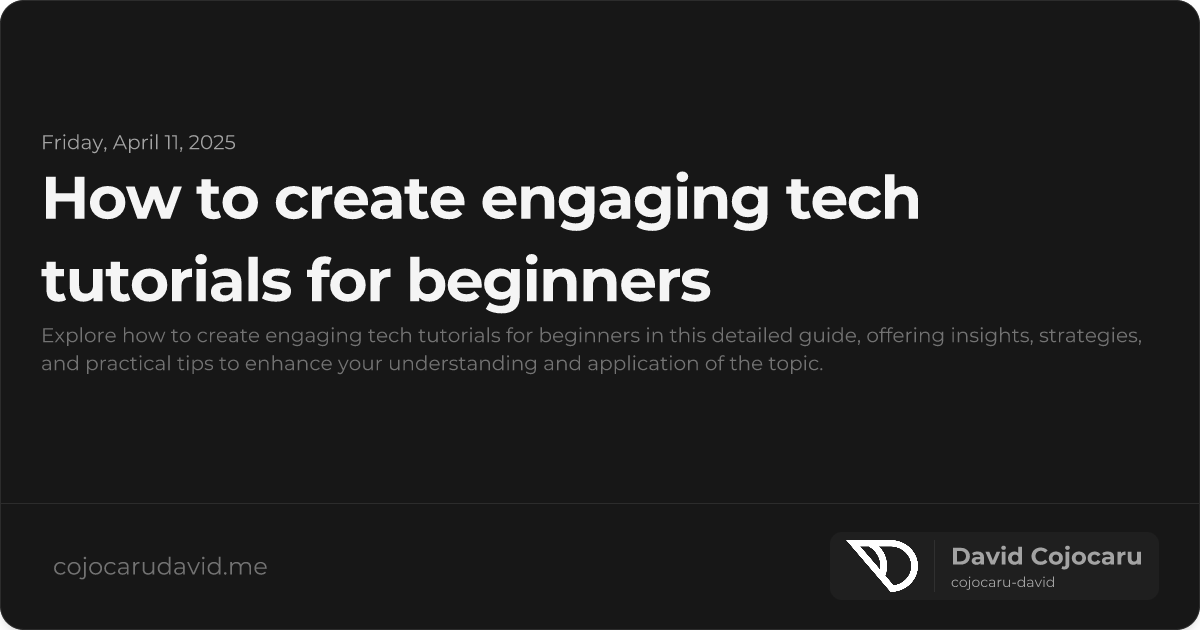Level Up Your Teaching: Crafting Engaging Tech Tutorials for Beginners
Tech tutorials are a fantastic way to empower beginners with new skills, but holding their attention can be tricky. Whether you’re writing blog posts, recording videos, or designing interactive courses, the secret lies in transforming complex topics into simple, enjoyable experiences. This guide dives into how to create engaging tech tutorials for beginners that not only educate but also inspire and retain your audience.
Know Your Student: Understanding Your Audience
Before you type a single word or record a second of video, understand who you’re teaching. Beginners have vastly different needs compared to intermediate or advanced learners.
- Identify Their Pain Points: What are the biggest hurdles they face when trying to learn this specific topic? What frustrates them?
- Determine Their Goals: Are they learning for fun, to boost their career prospects, or to solve a specific problem? Understanding their motivation is key.
- Assess Their Skill Level: What foundational knowledge do they already possess? Avoid overwhelming them with jargon; always explain new terms clearly.
Tailoring your content to their experience level will keep them engaged and prevent them from feeling lost or discouraged.
Simplify the Complex: Breaking Down Technical Concepts
Technical terminology can be a major barrier for beginners. Make your explanations crystal clear by:
- Using Analogies and Metaphors: Relate abstract concepts to familiar, everyday objects or situations (e.g., “Think of an API like a waiter in a restaurant—it takes your order and brings you what you need.”).
- Providing Real-World Examples: Show how the concept is used in practical scenarios they can relate to (e.g., “A variable is like a container for storing information, such as someone’s name or age.”).
- Structuring Lessons into Bite-Sized Chunks: Break down large topics into smaller, more manageable pieces. This prevents information overload.
Instead of immediately throwing learners into complex coding structures, consider starting with a basic example:
Imagine you want to greet someone:
- Input: Their name
- Process: Combine “Hello” with their name.
- Output: Display “Hello [Name]”
This simplified illustration makes even programming concepts more accessible.
Show, Don’t Just Tell: Use Visuals and Interactive Elements
Visual aids dramatically improve information retention. Supercharge your tutorials with:
- Diagrams and Charts: Use flowcharts to illustrate algorithms or system processes.
- Screenshots and GIFs: Capture key steps in software tutorials to guide learners visually.
- Interactive Exercises and Quizzes: Encourage hands-on practice with mini-challenges and knowledge checks.
A carefully chosen image or diagram can convey information more effectively than paragraphs of text.
Guide Them Step-by-Step: Practical, Actionable Instructions
Beginners learn best by doing. Structure your tutorials as actionable guides:
- Clearly Define the Objective: What will the learner be able to accomplish by the end of the tutorial? (e.g., “Learn to build a basic website”).
- List All Prerequisites: Specify the tools, software, or prior knowledge needed to complete the tutorial successfully.
- Provide Clear, Numbered Steps: Use concise, step-by-step instructions, supplementing them with code snippets or screenshots where appropriate.
- Include Troubleshooting Tips: Anticipate common mistakes and provide solutions to help learners overcome obstacles.
For instance, if your tutorial involves setting up a development environment:
- Download and install [Software Name] from [Link to Download].
- Open the application and follow the on-screen prompts.
- If you encounter an error message [Error Message], try [Solution].
This approach ensures a smoother learning experience and minimizes frustration.
Spark Curiosity: Encourage Engagement and Feedback
An actively engaged learner is far more likely to complete your tutorial and retain the information. Encourage interaction by:
- Posing Thought-Provoking Questions: Prompt learners to think critically about the concepts (e.g., “How could you use this concept in a different scenario?”).
- Including Quizzes and Self-Checks: Provide opportunities for learners to test their understanding and identify areas where they need further review.
- Inviting Comments and Discussion: Create a community where learners can ask questions, share their experiences, and learn from each other.
Soliciting feedback also allows you to continuously improve your tutorials and cater to the evolving needs of your audience.
Polish and Promote: Optimize for Readability and SEO
Even the most brilliant tutorial won’t be effective if it’s difficult to find or read. Enhance its visibility and clarity by:
- Using Descriptive Headings (H2, H3): Structure your content logically to improve readability and SEO.
- Incorporating Relevant Keywords Naturally: Integrate keywords that beginners might use when searching for information (e.g., “easy tech tutorials,” “programming for dummies”).
- Writing Short, Concise Paragraphs: Break up large blocks of text to make your content easier to scan and digest.
- Utilizing Bullet Points and Lists: Organize information in a visually appealing and easily digestible format.
A well-structured and optimized post not only ranks higher in search results but also keeps readers engaged longer.
Empowering the Next Generation: Conclusion
Creating engaging tech tutorials for beginners is an art that combines simplicity, interactivity, and practical application. By understanding your audience, demystifying complex concepts, and incorporating visuals, you can create tutorials that not only educate but also inspire a lifelong love of learning.
“Tell me and I forget. Teach me and I remember. Involve me and I learn.” - Benjamin Franklin
So, start putting these techniques into practice today, and watch as your tutorials become a valuable resource for aspiring tech enthusiasts!

